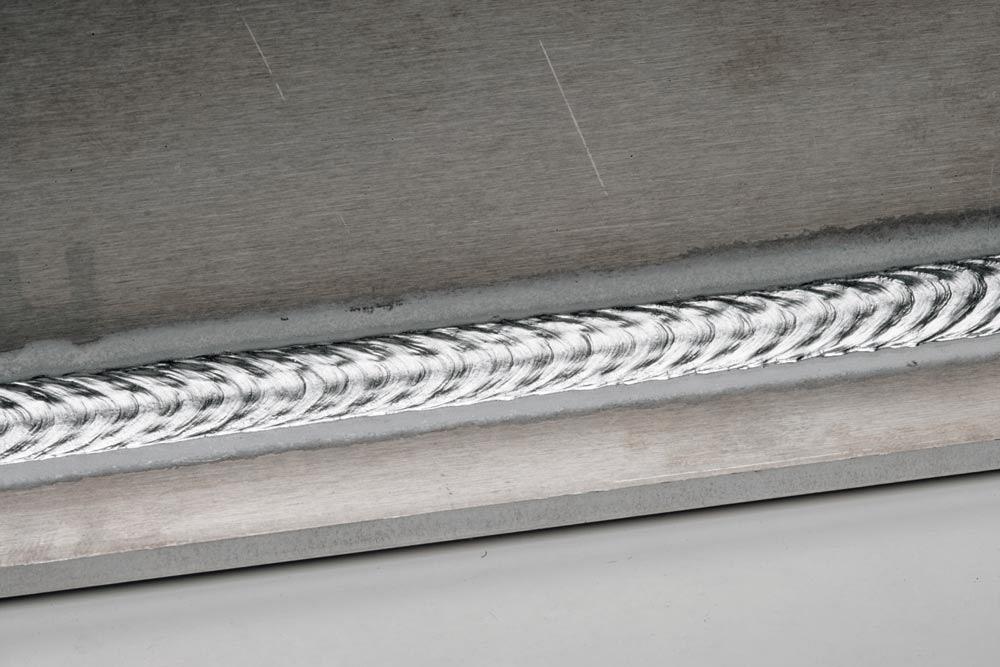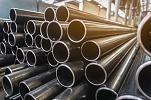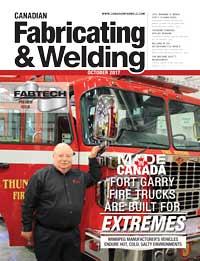Applications Manager, Aluminum Solutions
- FMA
- The Fabricator
- FABTECH
- Canadian Metalworking
Understanding your consumable options for aluminum welding
How to choose between the two most common filler metals
- By Mikael Carriere
- Updated February 13, 2023
- November 1, 2017
- Article
- Welding

Understanding the difference between the types of aluminum fillers can help determine which is the right fit for your job or if a different option would be more suitable.
Aluminum welding is becoming more prevalent as manufacturers strive to create light, durable products. The choice of filler metal for aluminum often comes down to one of two alloys: 5356 or 4043. These two account for between 75 and 80 per cent of aluminum welding jobs. The choice between the two or another option depends on the alloys of the base material being welded and the properties of the electrodes themselves. Understanding the difference between the two can help determine which is the right fit for your job or if a different option would be more suitable.
Crack Resistance
One of the benefits of 4043 is that it has a high crack resistance, so for welding weldments that are crack-sensitive, it is the better choice. The reason for this is that it is a more fluid weld metal with a very narrow freezing range. The freezing range is the temperature range at which the material is both partially liquid and partially solid. If there is a large temperature difference between the all-liquid and all-solid line, cracking is possible. The benefit of 4043 is that it lands close to the eutectic temperature, where it changes from solid to liquid without much in between.
The fluidity and capillary action that takes place in welding 4043 makes it better for sealing components. For instance, heat exchangers often are welded with 4043 for this reason.
Even if you are welding on 6061, which is a very common alloy, if you use too much heat and too much penetration in that base metal, there is a lot more chance of it cracking, so in some cases 4043 is the preferred choice with this alloy. However, people do use 5356 to weld 6061 often. In this case, it really depends on the conditions. Filler 5356 has other benefits that make it valuable for welding 6061.
Finish
The other main benefit of 4043 is that it produces a very bright finish and a lot less sooting, which is the black lines you might see on the edge of a 5356 weld. This sooting shouldn’t appear on the weld, but you will get frosting lines at the toe, and right outside of that is a black strip. That’s magnesium oxide. You don’t get that with 4043, which is valuable if you are working on a part for which you want to reduce after-weld cleanup.
Crack resistance and a bright finish are two of the main reasons that 4043 is chosen for particular jobs.
Colour match between the weld and the base metal can be an issue for 4043, however. This is a concern when the weldment is going to be anodized after welding. If you use 4043 on a part, after anodizing the weld will turn black, which is generally not ideal.
Electrical Conductivity
One of the drawbacks of using 4043 is that it has high electrical conductivity. If the electrical conductivity of an electrode is high, you need more amperage to burn off the same amount of wire because not as much resistance is built up, which is what creates the heat that makes a weld possible. With 5356 you’ll tend to be able to achieve higher wire feed speeds, and that’s a good thing when it comes to throughput and weld wire laid per hour.
Because 4043 has a higher electrical conductivity, it requires more energy to burn the same amount of wire. This results in a higher heat input, therefore making it more difficult to weld thin material. If you are working on thin material and are having a difficult time, use 5356 because it’s easier to get the parameters right. You can weld a bit faster, and you won’t get burn-through on the back side of the plate.
Strength and Ductility
Another con in using 4043 is that it has low strength and ductility. It’s typically not recommended for welding, for example, 2219, a 2000 series heat-treatable copper alloy. Typically, if you’re going to be welding 2219 to itself, you want to use a 2319, which will give you much better strength.
The low strength of 4043 makes it tougher to feed through welding systems. If you are looking at using a 0.035-in.-diameter 4043 electrode, you are going to run into problems with feeding because it’s very soft and has a tendency to buckle inside the gun’s liner. A lot of times people use push/pull guns to get around that, but push guns aren’t advisable because the pushing action can cause this buckling.
In comparison, 5356 has a higher column strength, which makes it easier to feed. This is what makes it beneficial in many cases when welding alloys like 6061: you get faster feed speeds, higher strength, and fewer feeding problems.
High-temperature Applications
High-temperature applications, anything around 150 degrees F, are another area where 4043 is very effective.
However, this depends again on the makeup of the base alloy. One problem that you might run into with aluminum-magnesium alloys, the 5000 series, is stress corrosion cracking if the magnesium content is above 3 per cent. Alloys such as a 5083 base plate generally aren’t used in high-temperature applications. The same can be said for 5356 and 5183. For magnesium alloy base plates, 5052 is commonly used, welded to itself. In this case, a 5554 has low enough magnesium content that it doesn’t exhibit stress corrosion cracking. It is the most common filler metal welders use when they want the strength of a 5000 series. The strength is lower than the typical weld but still exhibits the strength necessary in an application that requires temperatures above 150 degrees F.
There are other applications in which a third alternative is preferable to 4043 or 5356, of course. For instance, if you are welding something like a 5083, which is a higher-strength magnesium alloy, you would want to go with a filler metal that is higher strength, too, like a 5556 or a 5183 or 5556A, which are all high-strength consumables.
However, 4043 and 5356 remain a common choice for many jobs. It’s a matter of choosing between the benefits of the feed speed and low electrical conductivity of 5356 and the various benefits 4043 offers to determine which best suits your job.
Mikael D. Carriere, is applications manager, aluminum solutions, at Lincoln Electric Canada, 416-421-2600, www.lincolnelectric.ca.About the Author
subscribe now


Keep up to date with the latest news, events, and technology for all things metal from our pair of monthly magazines written specifically for Canadian manufacturers!
Start Your Free Subscription- Trending Articles
BlueForge Alliance partners with Nuts, Bolts & Thingamajigs to develop Submarine Manufacturing Camps

Portable system becomes hot tech in heat treatment

Orbital tube welding webinar to be held April 23

Cidan Machinery Metal Expo 2024 to be held in Georgia May 1-2

Corrosion-inhibiting coating can be peeled off after use

- Industry Events
MME Winnipeg
- April 30, 2024
- Winnipeg, ON Canada
CTMA Economic Uncertainty: Helping You Navigate Windsor Seminar
- April 30, 2024
- Windsor, ON Canada
CTMA Economic Uncertainty: Helping You Navigate Kitchener Seminar
- May 2, 2024
- Kitchener, ON Canada
Automate 2024
- May 6 - 9, 2024
- Chicago, IL
ANCA Open House
- May 7 - 8, 2024
- Wixom, MI















